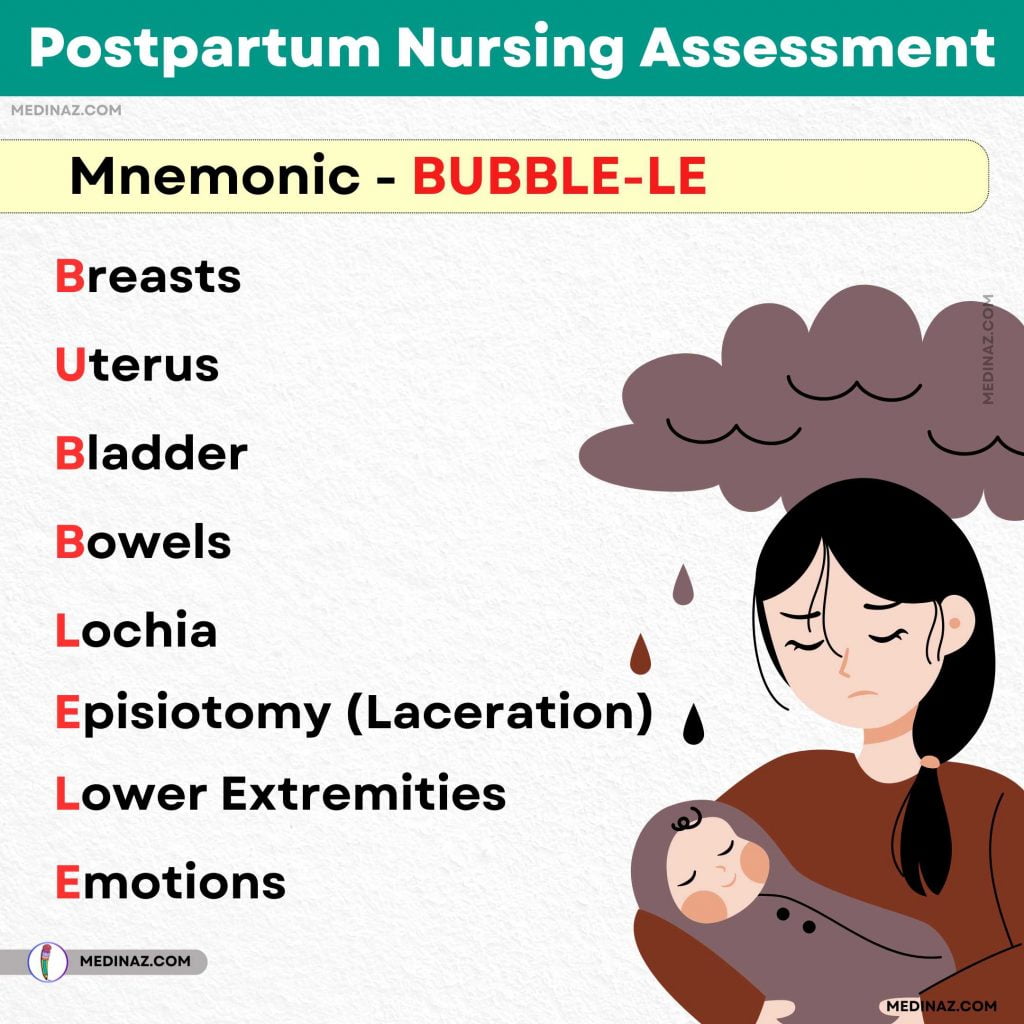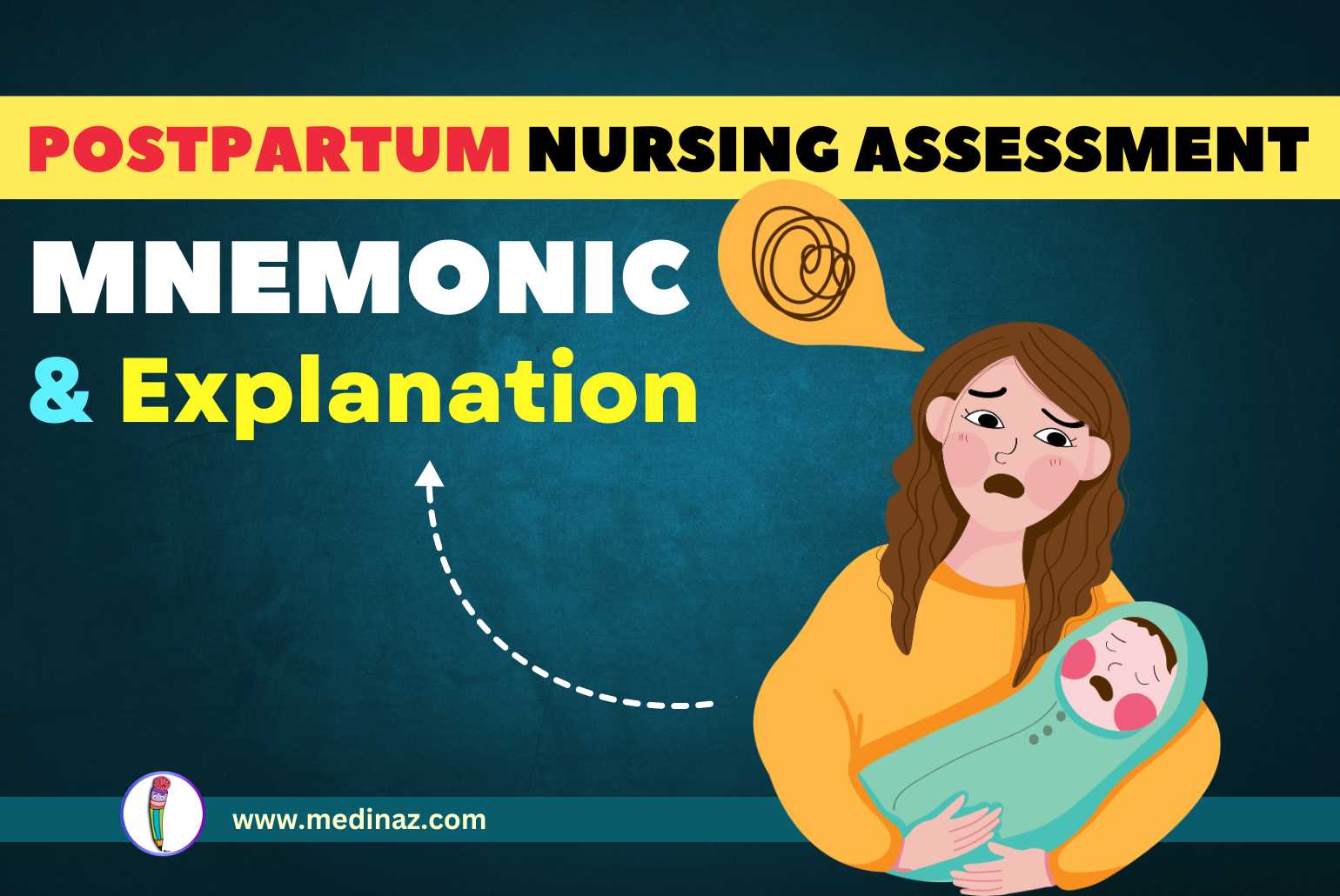Postpartum Nursing Assessment with Mnemonic
Conducting a thorough postpartum nursing assessment is crucial to promptly detect any potential complications following childbirth. After delivery, women are vulnerable to various issues like infection, hemorrhage, and Deep Vein Thrombosis (DVT). To aid in this assessment, nurses can utilize the mnemonic BUBBLE-LE, covering key areas such as breasts, uterus, bladder, bowels, episiotomy, lower extremities, and emotional well-being.
Postpartum Nursing Assessment with Mnemonic
Remember “BUBBLE – LE”
BUBBLE-LE is an acronym to remember the key points for postpartum nursing assessment. “BUBBLE – LE” stands for:
Breasts
Uterus
Bladder
Bowels
Lochia
Episiotomy (Laceration)
Lower Extremities
Emotions

Breasts:
The initial breast milk, colostrum, is rich in bioactive elements such as immunoglobulins and growth factors. Within 72-96 hours, as the milk transitions, breasts may feel heavier, fuller, and slightly firm with nodules. It’s important to monitor for signs of infection like mastitis, indicated by pain, redness, and warmth in the breasts.
Uterus:
To prevent postpartum hemorrhage, it’s crucial for the uterus to stay firm and contract. If it feels soft or boggy, gentle massage is necessary. Any deviation of the uterus to one side might suggest bladder distention and requires attention.
Bladder:
After childbirth, some women may encounter challenges with urination, leading to a distended bladder. This condition poses a heightened risk of hemorrhage as the pressure from the distended bladder affects the uterus.
Bowels:
The woman may experience delayed bowel movements for 2 or 3 days postpartum due to factors like pain, reduced food intake, dehydration, and discomfort from lacerations or hemorrhoids. To facilitate easier bowel movements, a stool softener may be administered.
Lochia:
Assessing the lochia is crucial for monitoring postpartum recovery, focusing on color, volume, and odor. Excessive lochia may signal hemorrhage, while a foul odor could indicate infection. Following childbirth, lochia typically appears bright red and may contain small clots. This initial discharge, known as lochia rubra, is the normal shedding of blood and decidua and persists for the first few days post-delivery.
Subsequently, around day 3-4, it transitions to a pink/brown hue containing serum and leukocytes, termed lochia serosa. By approximately 10 days postpartum, it becomes yellow/white with mainly leukocytes, known as Lochia Alba. Lochia typically persists for 4-8 weeks after birth.
Episiotomy (Laceration):
If the woman underwent an episiotomy, the nurse needs to check for signs of redness, swelling, bruising, discharge, and proper healing.
Lower Extremities:
Assessing the lower extremities for signs of deep vein thrombosis (DVT) is crucial postpartum. This involves checking for redness, warmth, and swelling, as DVT can lead to pulmonary embolism, characterized by symptoms like tachycardia and shortness of breath. While there’s debate about the reliability of Homan’s sign (pain in the calf muscle upon dorsiflexion – positive sign is pain in the calf muscle indicating a thrombus), mothers are at risk of DVT due to elevated clotting factors post-birth and prolonged bed rest.
Emotions:
Changes in hormones and the birth process itself can trigger intense emotions in new mothers. It’s important for nurses to gauge the mother’s emotional state to identify signs of postpartum blues. Additionally, offering tailored education based on her requirements can be beneficial. So, E can also suggest “Education”
Check other Medinaz Visual Notes
A Visual Learning Platform

